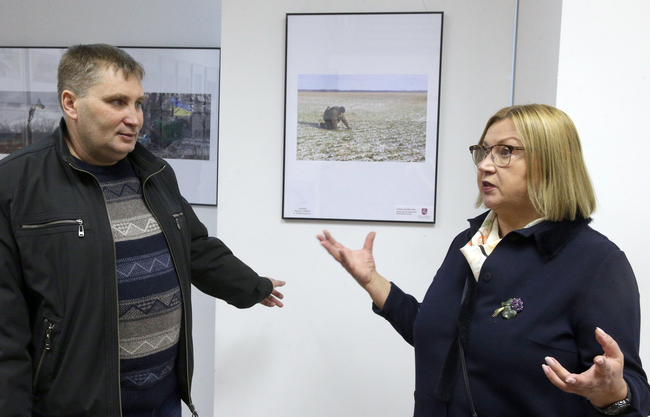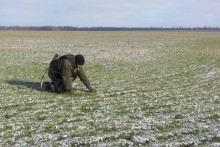Yurii Fomenko was born in Melitopol and told me he had breathed from early years “the very air which Dmytro Dontsov once breathed.” But his family is rooted in southern Cherkasy and Kropyvnytskyi regions, where his Ukrainian peasant ancestors lived for centuries, some of them participants of the Kholodny Yar rebellion. Seven relatives of his on both parents’ sides died during the terrible Holodomor of 1933. Fomenko saw a family tree of his ancestors painted on the back of his grandmother’s clothes chest. True to his farming ancestry, he worked in agribusiness in time of peace, and when the war in Donbas came, went to defend the Ukrainian land. It was there that the famous picture was taken which made Fomenko a celebrity. It showed a Ukrainian agronomist in soldier’s uniform inspecting… shoots of winter crops on the battlefield. This fantastic picture made Fomenko a friend of this newspaper and won an award at the Den-2015 Photo Contest. While on leave in the summer of 2015, the soldier met Den’s staffers and editor-in-chief in person and presented a chevron of his battalion to the latter, receiving books from Den’s Library series in return. Larysa Ivshyna and Fomenko then met again in Dnipro, where they took a memorable photo of themselves standing beside the “historic” picture. The anti-terrorist operation (ATO) veteran told Den/The Day’s reporter the story behind the unique picture and discussed his current job.
Under what circumstances was that famous picture taken?
“To be honest, it was an accidental frontline photo. A sergeant seized the occasion when I inspected winter wheat in the field, the procedure which we agronomists call ‘taking a monolithic sample.’ It involves digging out a clod of chernozem which contains winter crops and counting the number of seeds that have sprouted. We then calculate the ratio of seeds sprouted to seeds sown in this field, enabling us to understand what harvest is to be expected this year. He caught me at it. The picture then appeared on Facebook and Den’s editor-in-chief Larysa Ivshyna saw it there. It got her interested. The newspaper’s journalist Valentyn Torba contacted me and made an interview based on that picture. Later on, the picture, entitled Antaeus, won the photo competition held to sum up 2015, and I became ‘famous.’”
Where were you stationed at the time?
“I was stationed near the village of Kodema, Bakhmut raion, Donetsk oblast. It is effectively on the northern outskirts of Horlivka. This field, despite the fighting, was still being farmed, it had not been abandoned. They managed to till and sow it in the fall of 2014, although farming in the frontline ‘gray zone’ is an extremely risky business. In some fields, we helped farmers to harvest the crop, because it was their living, their only income source. Overall, life is fairly grim in the area. Their work is not only difficult, but dangerous as well. Our battalion was stationed in the Bakhmut raion for nine and a half months, our positions were close to the farm of the Kaplia brothers. They are formidable guys. In that time, they had three diesel generators and one combine harvester damaged and three tractor drivers wounded. Working in the fields under such conditions is much more dangerous than manning a checkpoint. One of their tractors suffered a direct hit while doing agrotechnical protection. Their vehicles hit landmines a few times as well... Kodema got hit by almost 30 Grad rockets, landing in the village itself, on January 21 and then after a day’s interval on January 23, 2015. Luckily, no one was hurt. Still, a local was killed during a later shelling. This is how the real war looks like: sometimes we got hit by aimed fire, and sometimes there was totally useless shooting in the ‘gray zone.’ Nonetheless, people live and work there. Many people have nowhere to go because they have no shelter elsewhere. They are simply hostages of this situation. It is truly terrible.

Photo by Artem SLIPACHUK, The Day
“I served in the 43rd Territorial Battalion, which was formed in Dnipro during the third wave of mobilization. Virtually all of us were volunteers and came to the military commissariat on our own because we wanted to defend Ukraine. They sent us to the Donbas in early October 2014 and we stayed there until the end of September 2015. We spent almost all this time at the forefront. At first I was the commander of a first line checkpoint. I was responsible for two dozen soldiers, their weapons, and a stretch of the frontline. Later on, they transferred me to the command of a strongpoint on the frontline. During the Soviet era, I served as an army sapper sergeant, but it was a totally different matter. It happened so that I had to perform my constitutional duty both in the Soviet Union, where I was looking for ‘the specter of imperialism’ through my assault rifle sights, and in independent Ukraine, but on that latter occasion, I was looking for ‘the specter of communism’ which had transformed into the Russian imperialism.”
What did you do for living before the war?
“I am economist-organizer of agricultural production by trade, having graduated from Dnipro Agricultural Institute. But it so happened that I began working as a foreman and stayed in technical jobs for my entire career... I was an agronomist, served as a deputy director for some time, and when collective farms went extinct, I decided to strike on my own and went into soft landscaping. I was involved with two such projects in Dnipro: luxury estate Zoloti Kliuchi and slopes around the Dnipro Arena soccer stadium. Having completed my tour of duty, I joined the Miskzelenbud municipal enterprise and I am now doing soft landscaping work in Dnipro.”
The team of the city’s mayor Borys Filatov includes many ATO veterans. Was it he who invited you?
“Let us just say I had a proposal which the mayor supported, and I then joined Miskzelenbud. In fact, I returned to the field I had worked in before. I was instructed to bring order to the existing green spaces that we already had and improve their quality and composition.
“You see, many trees are nearing the end of their lives and we need to replace them. But the replacement must be reasonable, so as to preserve the beauty of the city and not to harm it. Thus, everything has to be calculated in advance, and we need to complete a most thorough study of this issue. We need it to establish many interesting green areas in the city which will beautify Dnipro and improve its standing among the cities of Ukraine. After all, state-building is not just about symbols which are talked about daily, but requires daily work of utility companies to maintain the city in good order as well. We need to pay attention not only to the downtown, but to the outer neighborhoods as well. We have done a lot of work to that end past year with the support of the municipality. We conducted it on the periphery of the city, where we planted more trees in existing parks, worked on maintenance of green spaces and fought quarantine-covered weeds...
“We are now developing plans for improving more than 50 streets of the city. The trees that are not able to bring beauty and are in a very poor condition will definitely be replaced. The illegally paved-over locations will have planting holes re-dug and trees planted. The streets will be soft-landscaped based on architectural objectives. The formerly existing rules called for 50 square meters of greenery per capita. But according to the calculations of our scientists, we have just 14.4 square meters now.
“It so happened that we have many trees which were planted in the 1950s and 1960s, and activists’ loud protests notwithstanding, they are at the end of their lives. We need to replace them correctly, not suddenly, but so as not to leave the streets without green areas even for a while, but change their looks in 10 to 15 years instead.”
Many cities’ residents are voicing complaints about rejuvenating trees in winter. Is that a right thing to do?
“You can cut branches in winter, but you must understand the technology. You cannot ‘do surgery with a kitchen knife.’ Dnipro was planted with acacia and poplar trees in the post-World War Two years. They are the glory of the city. It should be understood, however, what our climate will be like in 30 years. Scientists say average temperatures will rise by two to three degrees. Because of this, we do not plant birch and chestnut trees, all the more so that chestnuts have been stricken with a highly resistant pest. What could replace them? It can be the plane, the Swedish whitebeam, or the Norway maple. Catalpas, with their large heart-shaped leaves, can work as well. Acacias will also be preserved, while speaking of poplars, we are sawing down only cotton-producing (female) trees. It has sent the city into a veritable psychosis, but it should be done. Most of our poplars are old, and their branches start dying at the age of 45, plus their wood gets loose. Even if such a tree survives rejuvenation, new growth is heavy and the tree poses a threat to roofs, people, and cars. When such a tree falls, the concerned public is outraged, even though it is they who protect these trees.”
On the eve of Dnipro’s 200th anniversary, an initiative was launched to create 200 green spots amidst the buildings and at intersections. People planted trees and shrubs and put up fountains and benches there. Today they are abandoned or destroyed by developers. Does it make sense to revive them?
“The municipality has set out to make the city comfortable for living. It includes creating small green areas and city gardens, which would be conveniently accessible for all townspeople, including mothers with young children, school-aged kids, and seniors. We are exploring what can be done by the city, our districts or sponsors. The desire to do it is paramount, and even money is less important. There are many people who help our soft-landscaping effort in the city. For example, the Promarmatura company purchased at its own expense and planted 100 plane trees in the Sahaidak Park. They will water the trees as well. We also have businessman Oleksii Shokh, who bought sakuras and restored the chess alley in the Shevchenko Park, and Yevhen Zhyrko and his lads, who restore wells so that people can enjoy clean water. In fact, there are many such individuals.”







